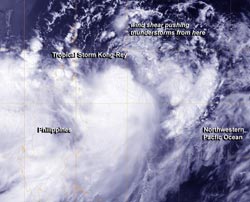NASA Sees Tropical Storm Kong-Rey Battling Wind Shear

NASA's Aqua satellite passed over Tropical Storm Kong-Rey on Aug. 27 at 0515 UTC and saw the northern quadrant had the weakest area of thunderstorm development as a result of northeasterly wind shear, while the southern and western quadrants had strong thunderstorms. Image Credit: NRL/NASA<br>
NASA's Aqua satellite passed over Tropical Storm Kong-Rey on Aug. 27 at 0515 UTC/1:15 a.m. EDT and the Moderate Resolution Imaging Spectroradiometer took a visible image of the storm.
The imagery showed that the northern quadrant of the storm had the weakest area of thunderstorm development as a result of northeasterly wind shear, while the southern and western quadrants had strong thunderstorms.
Wind shear is expected to relax somewhat, allowing Kong-Rey to intensify over the next day before it begins weakening.
At 1500 UTC/11 a.m. EDT on Aug. 27, Kong-Rey's maximum sustained winds were near 50 knots/57 mph/92.6 kph and the Joint Typhoon Warning Center is predicting a slow intensification. Kong-Rey was centered near 20.5 north and 123.6 east, about 324 nautical miles south-southeast of Taipei, Taiwan. Kong-Rey is moving to the north at 8 knots/9.2 mph/14.8 kph.
Kong-Rey is expected to pass east of Taiwan and then a mid-latitude trough (elongated area of low pressure) moving in from the northwest is expected to push the storm in a northeasterly direction and weaken it in the next couple of days
Text credit: Rob Gutro
NASA's Goddard Space Flight Center
Media Contact
All latest news from the category: Earth Sciences
Earth Sciences (also referred to as Geosciences), which deals with basic issues surrounding our planet, plays a vital role in the area of energy and raw materials supply.
Earth Sciences comprises subjects such as geology, geography, geological informatics, paleontology, mineralogy, petrography, crystallography, geophysics, geodesy, glaciology, cartography, photogrammetry, meteorology and seismology, early-warning systems, earthquake research and polar research.
Newest articles

Silicon Carbide Innovation Alliance to drive industrial-scale semiconductor work
Known for its ability to withstand extreme environments and high voltages, silicon carbide (SiC) is a semiconducting material made up of silicon and carbon atoms arranged into crystals that is…

New SPECT/CT technique shows impressive biomarker identification
…offers increased access for prostate cancer patients. A novel SPECT/CT acquisition method can accurately detect radiopharmaceutical biodistribution in a convenient manner for prostate cancer patients, opening the door for more…

How 3D printers can give robots a soft touch
Soft skin coverings and touch sensors have emerged as a promising feature for robots that are both safer and more intuitive for human interaction, but they are expensive and difficult…




















